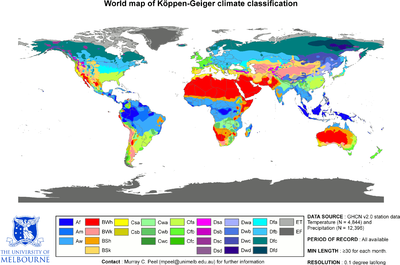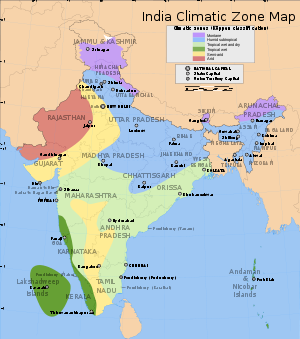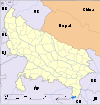- Climate of Uttar Pradesh
-
The Climate of Uttar Pradesh (U.P.) is primarily defined as Humid Subtropical with dry winter (CWa) type with parts of Eastern U.P. as Semi-Arid (BS) type. Alternatively, some authors refer to it as tropical monsoon. Variations do exist in different parts of the large state, however the uniformity of the vast Indo-Gangetic Plain forming bulk of the state gives a predominantly single climatic pattern to the state with minor regional variations. U.P. has a climate of extremes. With temperatures fluctuating anywhere from 0°C to 50°C in several parts of the state and cyclical droughts and floods due to unpredictable rains, the summers are extremely hot, winters cold and rainy season can be either very wet or very dry.
Contents
Background
Climate of Uttar Pradesh can be described using any one of the broad classification systems developed by climatologists over the years.
What is climate?
The word climate is derived from Ancient Greek klima, meaning inclination. It is defined by the American Meteorological Society as the weather averaged over a long period of time.[1] The standard averaging period is 30years,[2] but other periods may be used depending on the purpose. Climate also includes statistics other than the average, such as the magnitudes of day-to-day or year-to-year variations. The Intergovernmental Panel on Climate Change (IPCC) glossary definition is:
Climate in a narrow sense is usually defined as the "average weather," or more rigorously, as the statistical description in terms of the mean and variability of relevant quantities over a period of time ranging from months to thousands or millions of years. The classical period is 30 years, as defined by the World Meteorological Organization (WMO). These quantities are most often surface variables such as temperature, precipitation, and wind. Climate in a wider sense is the state, including a statistical description, of the climate system.[3]The difference between climate and weather is usefully summarized by the popular phrase "Climate is what you expect, weather is what you get".
Classification systems
Among the several ways to classify climate, two primary types of climate classification are broadly followed - empirical classification system (based on statistical information) and genetic classification system (based on cause/origin of different climatic phenomenons. Overtime the empirical systems have become more prevalent. Of these, the Köppen climate classification is most widely recognized.
Köppen climate classification
 Updated Köppen climate classification map[4]
Updated Köppen climate classification map[4]
 Köppen map of India
Köppen map of India Main article: Köppen climate classificationMain article: Climatic regions of India
Main article: Köppen climate classificationMain article: Climatic regions of IndiaFirst developed by climatologist Wladimir Köppen in 1884, and still one of the most widely used, it had 5 major groups each denoted by a primary alphabet A,B, C, D and E. Very rarely, alphabet H is used to represent a separate group.[4] Second (secondary) and third (tertiary) alphabets are used to depict further refinement and subdivisions for representation of each sub-category. This model is primarily empirical type as such based primarily on seasonal distribution (mean/average and variances) of temperature and precipitation for a given location. The name of the primary symbol and their representative groups are defined as below:
- Group A: Tropical/megathermal climates (humid and winterless like tropical rainforest climates)
- Group B: Dry (arid and semiarid) climates (like desert type)
- Group C: Temperate/mesothermal climates (humid and warm like Mediterranean climate)
- Group D: Continental/microthermal climate (cold forest type like taiga climate)
- Group E: Polar climates (mainly tundra type climate)
Group H, occasionally used, represents Montane or Alpine climate but often it is just considered to be a sub-division of Group E and not a separate group in itself. Group A,C,D and E have temperature as the main classification criteria. Only B is precipitation based. Further on, the secondary symbol is primarily precipitation based and tertiary symbol is primarily temperature based sub-classifications.
Based on Köppen classification, India has the following climate types in the country:
Am - Tropical Monsoon
Aw - Tropical Savannah/ Tropical wet & dry
BSh - Tropical and sub-tropical steppe
BS - Semi arid Steppe
BWh - Tropical desert/Arid
CWa - Humid sub-tropical with dry winter
E - AlpineSeasons of India
Indian Meteorological Department (IMD) breakdowns the climate of India into the following seasons[5][6] :
- Winter Season / Cold Weather Season (January and February)
- Summer season/ Pre-monsoon season/ Hot weather season/ Thunderstorm season (March, April and May)
- South-west Monsoon/ Summer Monsoon (June, July, August and September)
- Post-monsoon or Northeast monsoon or Retreating SW Monsoon season (October, November and December)
This classification is primarily Monsoon centric given the vast effect that it casts on the lives and agriculture of India.
Classification of Uttar Pradesh Climate
The climate of Uttar Pradesh is generally defined to be tropical monsoon type.[7] However based on the Köppen climate classification, it can be classified mostly as Humid Subtropical with dry winter (CWa) type with parts of Eastern U.P. as Semi-Arid (BS) type (refer to map of India above)
Based on IMD classification, UP has the following three predominant seasons[8][9] :
- Winter Season - November to February
- Summer season - March, April and May
- South-west Monsoon - June, July, August, September and October
Retreating Monsoon season, although existent, has a very negligible effect in Uttar Pradesh and only occasional mild showers are experienced in winter. Some of these showers are not even due to the Monsoon but due to western disturbances.[10]
The primary temperature, rainfall and wind features of the three Distinct Seasons of U.P. can be summarized as below:
- Summer (March–June): Hot & dry (temperatures rise to 45 °C, sometimes 47-48 °C); low relative humidity (20%); dust laden winds.
- Monsoon (June–September): 85% of average annual rainfall of 990 mm. Fall in temperature 40-45° on rainy days.
- Winter (October–February): Cold (temperatures drop to 3-4 °C, sometimes below -1 °C); clear skies; foggy conditions in some tracts.
Given significant climatic differences, U.P. has been divided into two meteorological sub-divisions - U.P. East and U.P. West.[11]
Geographical terrain
The state of Uttar Pradesh is in the heart of Indo-Gangetic Plain with River Ganges flowing right through it, Himalayas to the north of it and the Chota Nagpur Plateau and the Vindhyas to the south of it.
Temperature
Temperature varies from 0 to 46°Cs.[9] High temperatures of around 50°C have been recorded in Gonda district of U.P.[7] Given such a wide range of temperature fluctuations in most parts of the state, it can lead to either cold waves or heat waves both resulting in substantial loss of live and economy.
Heat waves
In 2007, Banda with 45.5 °C temperature was the leader in terms of hot districts of U.P. for several days.[12] At least 62, people were reportedly dead during the heat wave that year.[13] In June 2009, 30 people died of heatstroke in U.P.[14] Highest temperatures reached 49°C in Bundelkhand district of northern U.P.[15][16] In June 2010, Jhansi recorded the highest temperature of 46.7°C, the hottest for U.P. for that year.[17]
Cold Waves
In recent years, winters at the end of 2007 and beginning of year 2008 caused a string of cold-wave related deaths in U.P.[18] with temperatures as low as 2.8°C in the city of Meerut, U.P. Simultaneously it also led to a loss of crops and agricultural produce. Similarly last part of 2009, saw the mercury-dipping to lows of 2.9°C in Meerut again causing loss of human life.[19] End of 2010 and starting of 2011 was no different with winters bringing news of cold-wave related deaths.[20][21] This time Churk town in Mirzapur district ranked coldest with 1.4°C.[20]
Precipitation
It rains over most of U.P. with very few arid or semi-arid patches. Snowfall is negligible but hail-storms, frost and dew occur often in U.P. The type of rainfall that U.P. receives is orographic, cyclonic and convectional.[9]
Rain
Primarily a summer phenomenon, the Bay of Bengal branch of the Indian Monsoon is the major bearer of rain in most parts of U.P. It is the South-West Monsoon which brings most of the rain here, although rain due to the western disturbances[10] and North-East Monsoon also contribute small quantities towards the overall precipitation of the state.[9] The rain in U.P. can vary from an annual average of 170 cm in hilly areas to 84 cm in Western U.P.[9] Given the concentration of most of this rainfall in the 4 months of Monsoon period, excess rain can lead to floods and shortage to droughts.[7] As such these two phenomenons of floods and droughts are a common recurrence in the state.
Floods in U.P.
Floods are a known hazard of U.P. due to overflowing of its main rivers like Ganga, Yamuna, Ramganga, Gomti, Sharda, Ghaghra, Rapti and Gandak.[11] Estimated annual losses due to floods in U.P. is
 432 crore (US$87.61 million).[11] Major flood management efforts have been undertaken to mitigate the risk. Most of these floods occur due to the Monsoon rains and overflowing of rivers during the rainy periods. Year 2010 witnessed one such year of flooding in U.P.[22][23]
432 crore (US$87.61 million).[11] Major flood management efforts have been undertaken to mitigate the risk. Most of these floods occur due to the Monsoon rains and overflowing of rivers during the rainy periods. Year 2010 witnessed one such year of flooding in U.P.[22][23]Droughts in U.P.
Shortage of rain during the highly variable Monsoon season can cause droughts in U.P. leading to severe loss to man and property. Recent 2002 and 2004 drought related financial estimates have been reported to be
 7,540 crore (US$1.53 billion) and
7,540 crore (US$1.53 billion) and  7,292 crore (US$1.48 billion).[11] The recurrence of a major deficiency in annual rainfall follows a 6-8years cycle in Eastern U.P. whereas in Western U.P., it is a 10 years cycle.
7,292 crore (US$1.48 billion).[11] The recurrence of a major deficiency in annual rainfall follows a 6-8years cycle in Eastern U.P. whereas in Western U.P., it is a 10 years cycle.Snowfall
Snowfall occurs only in the hilly areas of U.P.[9]
Wind
In summers, hot winds called loo blow all across U.P. They are dust-laden and quite damaging.[9] In winters, dry and rainless winds blow across the state. Fog may also form in parts of U.P.[9]
See also
- Geography of Uttar Pradesh (section of Climate)
- Uttar Pradesh (Section of climate)
- Climate
Class A Class B Class C Class D Class E  State of Uttar Pradesh
State of Uttar PradeshCapital : Lucknow Topics Divisions Districts Agra • Aligarh • Allahabad • Ambedkar Nagar • Auraiya • Azamgarh • Badaun • Bagpat • Bahraich • Ballia • Balrampur • Banda • Barabanki • Bareilly • Basti • Bijnor • Bulandshahr • Chandauli • Chitrakoot • Devaria • Etah • Etawah • Faizabad • Farrukhabad • Fatehpur • Firozabad • Gautam Buddha Nagar • Ghaziabad • Ghazipur • Gonda • Gorakhpur • Hamirpur • Hardoi • Jalaun • Jaunpur • Jhansi • Jyotiba Phule Nagar • Kannauj • Kanpur Dehat (Akbarpur) • Kanpur Nagar • Kanshiram Nagar • Kaushambi • Kushinagar (Padrauna) • Lakhimpur Kheri • Lalitpur • Lucknow • Mahamaya (Hathras) • Maharajganj • Mahoba • Mainpuri • Mathura • Mau • Meerut • Mirzapur • Moradabad • Muzaffarnagar • Pilibhit • Pratapgarh • Raebareli • Rampur • Saharanpur • Sant Kabir Nagar • Sant Ravidas Nagar (Bhadohi) • Shahjahanpur • Shravasti • Siddharthnagar • Sitapur • Sonbhadra • Sultanpur • Unnao • Varanasi
Major cities Portal : Uttar Pradesh Climate of India States Andhra Pradesh · Arunachal Pradesh · Assam · Bihar · Chhattisgarh · Goa · Gujarat · Haryana · Himachal Pradesh · Jammu and Kashmir · Jharkhand · Karnataka · Kerala · Madhya Pradesh · Maharashtra · Manipur · Meghalaya · Mizoram · Nagaland · Orissa · Punjab · Rajasthan · Sikkim · Tamil Nadu · Tripura · Uttar Pradesh · Uttarakhand · West BengalNCT Territories Andaman and Nicobar Islands · Chandigarh · Dadra and Nagar Haveli · Daman and Diu · Lakshadweep · PuducherryReferences
- ^ "Climate". Glossary of Meteorology. American Meteorological Society. http://amsglossary.allenpress.com/glossary/search?id=climate1. Retrieved 9 March 2011.
- ^ "Climate averages". Met Office UK. http://www.metoffice.gov.uk/climate/uk/averages/. Retrieved 9 March 2011.
- ^ "Glossary of Terms used in the IPCC Third Assessment Report". Intergovernmental Panel on Climate Change. http://www.ipcc.ch/pdf/glossary/tar-ipcc-terms-en.pdf. Retrieved 9 March 2011.
- ^ a b Peel, M. C. and Finlayson, B. L. and McMahon, T. A. (2007). "Updated world map of the Köppen–Geiger climate classification". Hydrol. Earth Syst. Sci. 11: 1633–1644. ISSN 1027-5606. http://www.hydrol-earth-syst-sci.net/11/1633/2007/hess-11-1633-2007.html. Retrieved 8 March 2011.
- ^ S D Attri and Ajit Tyagi. "CLIMATE PROFILE OF INDIA". Indian Meteorological Department. http://www.imd.gov.in/doc/climate_profile.pdf. Retrieved 9 March 2011.
- ^ "Climate". India.gov.in. http://india.gov.in/knowindia/climate.php. Retrieved 9 March 2011.
- ^ a b c Mathur, Raj B.. "Uttar Pradesh: Climate". Encyclopædia Britannica. http://www.britannica.com/EBchecked/topic/620898/Uttar-Pradesh/46085/Climate. Retrieved 9 March 2011.
- ^ "Home » Uttar Pradesh Profile » Geography » Climate". UPonline. http://www.uponline.in/Profile/geography/climate.asp. Retrieved 9 March 2011.
- ^ a b c d e f g h Upkar Prakashan - Editorial Board (2008). Uttar Pradesh General Knowledge. Upkar Prakashan. pp. 26–. ISBN 9788174824080. http://books.google.com/books?id=_ce8FpJzR-4C&pg=PA26. Retrieved 9 March 2011.
- ^ a b Sethi, Nitin (13 Feb 2007). "Met dept blames it on 'western disturbance'". Times of India. http://articles.timesofindia.indiatimes.com/2007-02-13/india/27887812_1_met-dept-disturbance-rains. Retrieved 9 March 2011.
- ^ a b c d "Disaster Management Department, Govt of U.P.". http://rahat.up.nic.in. http://rahat.up.nic.in/disaster_management.htm. Retrieved 9 March 2011.
- ^ "9 more succumb to heatwave in UP, rain claims 5 lives in south". OneIndiaNews.in. June 11, 2007. http://news.oneindia.in/2007/06/08/9-more-succumb-to-heatwave-in-up-rain-claims-5-lives-in-south-1181531156.html. Retrieved 10 March 2011.
- ^ "46 more perish in heat spell; toll crosses 100". The Hindu. June 11, 2007. http://www.hindu.com/thehindu/holnus/000200706112201.htm. Retrieved 10 March 2011.
- ^ "120 die in unrelenting heatwave across India". June 25, 2009. IOL.co.za. http://www.iol.co.za/news/world/120-die-in-unrelenting-heatwave-across-india-1.447520. Retrieved 10 March 2011.
- ^ "Deadly heatwave sweeps India". BreakingNews.ie. 26 Jun 2009. http://www.breakingnews.ie/world/deadly-heatwave-sweeps-india-416413.html. Retrieved 10 March 2011.
- ^ "Deadly heat wave sweeps India". Yorkshire Post. http://www.yorkshirepost.co.uk/news/around-yorkshire/local-stories/deadly_heat_wave_sweeps_india_1_2356608. Retrieved 10 March 2011.
- ^ "Heat tightens grip over N-India, Rajasthan hottest". Zeenews.com. June 20, 2010. http://www.zeenews.com/news635386.html. Retrieved 10 March 2011.
- ^ IANS (Jan 3, 2008). "Uttar Pradesh cold wave toll rises to 38". DNA. http://www.dnaindia.com/india/report_uttar-pradesh-cold-wave-toll-rises-to-38_1142961. Retrieved 9 March 2011.
- ^ "Three die due to cold in UP as winter firms its grip on north". Zeenews.com. December 27, 2009. http://www.zeenews.com/news590711.html. Retrieved 9 March 2011.
- ^ a b IANS (7 Jan 2011). "Four more die in freezing Uttar Pradesh, toll climbs to 63". Sify.com. http://www.sify.com/news/four-more-die-in-freezing-uttar-pradesh-toll-climbs-to-63-news-national-lbhuajfjfhh.html. Retrieved 9 March 2011.
- ^ "Rajasthan temperature dips to 0°, N India frozen". OneIndiaNews.com. January 6, 2011. http://news.oneindia.in/2011/01/06/rajasthan-temperature-dips-to-0-n-india-frozen.html. Retrieved 9 March 2011.
- ^ "Floods play havoc in Bihar & Uttar Pradesh". Samachar today. 28 Aug 2010. http://www.samachartoday.com/floods-play-havoc-in-bihar-uttar-pradesh/10174. Retrieved 9 March 2011.
- ^ "Nine die in Uttar Pradesh India floods: Toll 429". Climate Himalaya Initiative-NEWS. 2 Oct 2010. http://chimalaya.org/2010/10/02/nine-die-in-up-floods-toll-429/. Retrieved 9 March 2011.
Wikimedia Foundation. 2010.



